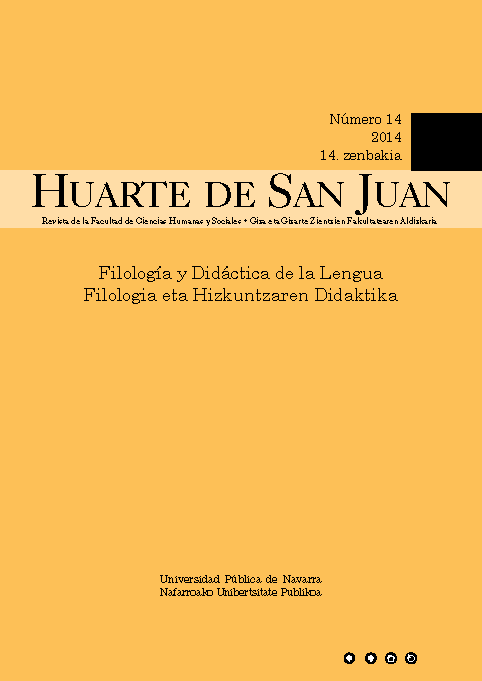Emakumearen irudia euskaltzaindiaren hiztegian
Keywords:
Euskatzaindiaren Hiztegia, gender, language, female, dictionaryAbstract
Although the Basque language is not a gender language, it reflects the characteristics and values of our patriarchal and androcentric society; moreover, it does not only reflect them, it also transmits and perpetuates them. Aim: to analyze roles, and prototypes of woman and man that are presented in Euskaltzaindiaren Hizegia and their statistical differences. It should be mentioned that the present study is the first quantitative study, an approach to what would be a full analysis, so the sample used does not contain all the susceptible words of Euskaltzaindiaren Hiztegia that can be studied. Results: The results showed that the treatment of women and men given in this dictionary is not equal. We can also say that the experience of women, their jobs, features, etc. appear in many fewer occasions than man´s ones. At the same time, the number of examples used to express the female words and those used for expressing male ones is not balanced. The differences are evident and the gap between the two genders is growing as the analysis becomes more specific, more concrete.
Downloads
References
Álvarez Uria, A. (2004-03-08): Euskara hizkuntza sexista al da? [Eskuragarri (2014-08-05): http://www.erabili.com/zer_berri/muinetik/1078235452].
Arana, Anuntzi (2005-10-05): Denok JENDE eta denen artekoa JENDARTEA. [Eskuragarri (2014-08-05): http://www.erabili.com/zer_berri/galdezka/1128146364/1128547592].
Barquín, Amelia (2008): Euskararen erabilera ez sexista, Gasteiz, Emakunde, Eusko Jaurlaritza.
Bengoechea Bartolomé, Mercedes et al. (2006-2009): Efectos de las políticas lingüísticas antisexistas y feminización del lenguaje, Madril, Instituto de la Mujer (Ministerio de Sanidad, Política Social e Igualdad).
Bibli Elkartea: Sarrera (1, 1-51). Jainkoaren hitza gizon egin. [Eskuragarri (2014-08-05): http://www.biblija.net/biblija.cgi?set=21&l=eu&pos=1&qall=1&idq=0&idp0=35&m=Jn%201&hl=Jn%201%2C1].
Casado G., E. (2002): Prototipos de la interacción pedagógica. [Eskuragarri (2014-08-05): http://www.scielo.org.ve/scielo.php?pid=S0798-97922002000200004&script=sci_arttext.].
Eustat: Euskal AEko biztanleria jaiotze urteari jarraiki, Lurralde Historiko eta sexuaren arabera. [Eskuragarri (2014-08-05): http://eu.eustat.es/ci_ci/elementos/ele0011400/ti_Poblacin_de_la_CA_de_Euskadi_por_ao_de_nacimiento_segn_el_territorio_histrico_y_el_sexo_2013/tbl0011424_e.html].
Euskaltzaindia (2011): Orotariko Euskal Hiztegia (2. arg.). [Eskuragarri (2014-08-05): http://www.euskaltzaindia.net/index.php?option=com_content&view=article&id=276&Itemid=413&lang=eu].
Euskaltzaindia (2012): Euskaltzaindiaren Hiztegia, Andoain, Elhuyar Fundazioa, Elkarlanean, Euskaltzaindia.
Lledó Cunill, Eulália; Calero Fdz., Mª Ángeles y Forgas Berdet, Esther (2004): De mujeres y diccionarios. Evolución de lo femenino en la 22.ª edición del DRAE, Madril, Instituto de la Mujer (Ministerio de Trabajo y Asuntos Sociales).
Moreno Fernández, F. (1998): Principios de sociolingüística y sociología del lenguaje, Bartzelona, Ariel.
Real Academia Española (2001): Diccionario de la lengua española, 22. arg., Madril, Espasa Libros.
Sarasola Errazkin, Ibon (2006): Euskal Hiztegia, Donostia, Elkarlanean.
Vargas, Ana et al. (1998): Lo femenino y lo masculino en el Diccionario de la Real Academia Española, Madril, Instituto de la Mujer (Ministerio de Trabajo e Inmigración).
XX. mendeko Euskararen Corpus estatistikoa. [Eskuragarri (2014-08-05): http://xxmendea.euskaltzaindia.net/Corpus/index.jsp?hasiera=false&aurreratua=true&atala=true].
Zubiri Ibarrondo, I. (2012): Euskal Atzizkibide Osoa, Bilbo, Ikasbook.
Downloads
Published
How to Cite
Issue
Section
License
All articles are published under a Creative Commons (BY-NC-ND 4.0) license. Each article will be assigned a DOI.
Authors retain copyright of their work and grant the journal the right to the first publication. Authors can sign additional agreements to non-exclusive distribution of the published version of the article (for example, in an institutional repository) as long as appropriate attribution to the original publication is provided. Articles can be uploaded to institutional repositories immediately after publication.
Electronic distribution of the articles (for example, academic social networks or personal webpages) is allowed and encouraged.
The journal reserves the right to publicise the work in social networks and other electronic means.







